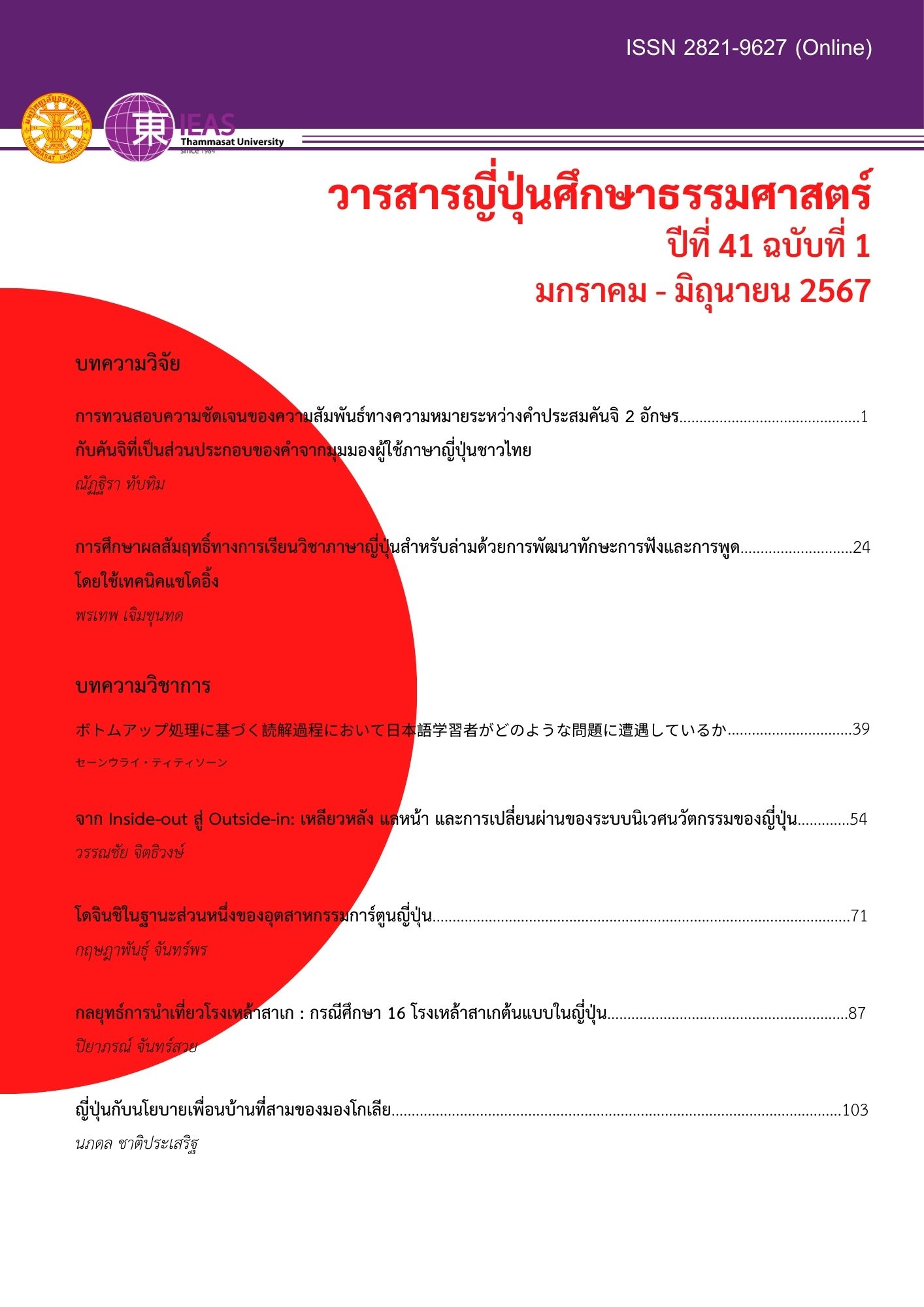The study on the learning effectiveness in Japanese interpretation: Integrated shadowing teaching techniques for enhancing listening and speaking skills
Keywords:
Learning effectiveness of listening and speaking skills, Learning Japanese, Japanese interpretation, ShadowingAbstract
The objectives of study on the learning effectiveness in Japanese interpretation: Integrated shadowing teaching techniques for enhancing listening and speaking skillswere: 1) to study on the learning effectiveness of listening and speaking skills in Japanese language courses using integrated shadowing teaching techniques for translator 2) to compare Japanese for Interpreter of listening and speaking skills using shadowing techniques and 3) to study the satisfaction of Japanese for Interpreter of listening and speaking skills using shadowing techniques. The instruments used in this research were: 1) active learning plan for Japanese for Interpreter of listening and speaking using shadowing techniques 2) two sets of pretest and posttest tests consisted of Japanese-Thai Interpreter and Thai-Japanese Interpreter. and 3) satisfaction questionnaires of the development of Japanese for Interpreter of listening and speaking using shadowing techniques.
The results of the pretest and posttest for Japanese interpreter listening and speaking using shadowing techniques exceeded the set criterion at a significance level of 0.04. Furthermore, the scores increased by 4.83 points, representing a 12.08% improvement when comparing the scores before and after participating in shadowing techniques. The results of the pretest and posttest for Japanese interpreter speaking-listening, segmented by participation in shadowing techniques, demonstrated an increase in scores. The group participating in shadowing techniques showed a higher improvement, with scores increasing by 8.67 points or 21.67%.
Regarding reliability, Cronbach’s Alpha-Coefficient was calculated at 0.91, indicating high reliability.
Finally, The satisfaction survey results for Japanese interpreter listening and speaking using shadowing techniques revealed very high satisfaction levels. Specifically, the satisfaction was highest in the aspect of the lecturer, followed by teaching and learning, teaching media, and an overview of developing listening and speaking skills.
Downloads
References
จิรัชยา งิ้วสีดา, ไพสิฐ บริบูรณ์ และ วิจิตรา วงศ์อนุสิทธิ์. (2559). การพัฒนากิจกรรมการเรียนรู้ภาษาอังกฤษเพื่อพัฒนาความสามารถในการฟังและการพูด โดยใช้เทคนิคแชโดอิ้ง สำหรับนักเรียนชั้นประถมศึกษาปีที่ 3. วารสารวิชาการหลักสูตรและการสอน, 8(21), 143-152.
ทัศนีย์ เมธาพิสิฐ. (2554ก). ประสิทธิภาพของการฝึกแชร์โดอิงค์เพื่อปรับปรุงการออกเสียงคำยืมในภาษาญี่ปุ่น. วารสารญี่ปุ่นศึกษา, 12(2), 67-79.
ทัศนีย์ เมธาพิสิฐ. (2554ข). ผลการฝึกแชโดอิ้งต่อการพัฒนาทักษะการพูด : ด้านความเร็วและความถูกต้อง. วารสารวิชาการของเครือข่ายญี่ปุ่นศึกษาแห่งประเทศไทย, 1(1), 78-89.
บุษบา บรรจงมณี. (2549). ทางลัดสู่...ล่าม. สำนักพิมพ์ภาษาและวัฒนธรรม.
ยุพกา ฟูกุชิม่า. (2556). ประสิทธิผลการฝึกเทคนิคแชโดอิ้ง ต่อการเรียนรู้เสียงสูงต่ำภาษาญี่ปุ่นของผู้เรียนชาวไทย. วารสารญี่ปุ่นศึกษา, 32(1), 71-90.
วรรณิดา ยืนยงค์ และ สมเกียรติ เชวงกิจวณิช. (2562, มิถุนายน). บทบาทหน้าที่ของล่ามและปัญหาการล่ามภาษาญี่ปุ่นชาวไทยในโรงงานอุตสาหกรรมของประเทศไทย กรณีศึกษาความแตกต่างระหว่างล่ามมือใหม่และล่ามมืออาชีพ [Paper presentation]. การประชุมวิชาการบัณฑิตระดับชาติ สรรพศาสตร์ สรรพศิลป์ ประจำปี 2562, กรุงเทพฯ, ประเทศไทย.
飯野 厚. (2014).『シャドーイング練習が英語スピーキング力とシャドーイングの認識に及ぼす効果』.法政大学多摩論集編集委員会.
玉井健. (2005).『リスニング指導法としてのシャドーイングの効果に関する研究』風間書房.
王鵬、胡小春. (2019).『シャドーイングによる日本語語学能力の向上の実証的研究』中央学院大学.
Downloads
Published
Issue
Section
License
Copyright (c) 2024 Thammasat Journal of Japanese Studies

This work is licensed under a Creative Commons Attribution-NonCommercial-NoDerivatives 4.0 International License.




